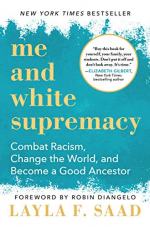
|
| Name: _________________________ | Period: ___________________ |
This test consists of 5 multiple choice questions, 5 short answer questions, and 10 short essay questions.
Multiple Choice Questions
1. The term "misogynoir" carries what meaning?
(a) Hatred directed at Black women in U.S. popular culture.
(b) Apathy directed at Black women in U.S. popular culture.
(c) Love directed at Black women in U.S. popular culture.
(d) Hatred directed at Black women in UK popular culture.
2. An acronym is which of the following?
(a) An abbreviation formed from initial letters and used as a word.
(b) A high-wire or trapeze act.
(c) An abbreviation formed from within a single word.
(d) A high name used to hide an identity.
3. The term “marginalized” carries what meaning?
(a) Pushed to the inside and made less important.
(b) Pushed to the inside and made more important.
(c) Pushed to the outside and made more important.
(d) Pushed to the outside and made less important.
4. Saad defines racism as which of the following?
(a) Egalitarianism absent systemic power.
(b) Prejudice coupled with systemic power.
(c) Prejudice absent systemic power.
(d) Egalitarianism coupled with systemic power.
5. In the book, the phrase “playing the race card” carries what meaning?
(a) An accurate description of difficulties BIPOC encounter coming from racism.
(b) A pejorative ascribing difficulties BIPOC encounter to equality.
(c) An accurate description of difficulties BIPOC encounter coming from equality.
(d) A pejorative ascribing difficulties BIPOC encounter to racism.
Short Answer Questions
1. The term “inclusivity” carries what meaning?
2. Saad uses which of the following definitions for being called out?
3. Which of the following does Saad cite in reviewing the third week of the work outlined in the book?
4. The term “hierarchical” carries what meaning?
5. The term “misogynoir” offers an example of which of the following?
Short Essay Questions
1. Saad points out that personal mental health and behavioral issues are not necessarily justifications for not doing antiracist work. What reason/s does she give for the assertion?
2. In moving into the second week of the work outlined in the book, Saad notes that those doing the work should not voice their discomfort to BIPOC if they are not BIPOC. What reason does she give for her statement?
3. What rhetorical appeal/s is / are made when Saad references Latham Thomas at length (212-13)?
4. Saad notes that mistakes are inevitable in effecting change. Why might it be a good thing that they are so?
5. What rhetorical appeal/s is / are made when Saad references Toni Morrison at length (183-85)?
6. Why, per Saad, is positive stereotyping harmful?
7. What is meant in the book by “representation,” particularly as pertains to Viola Davis’s speech (123-25)?
8. Saad makes a point of noting the backgrounds of the sources she cites throughout her book. What rhetorical appeal/s is / are made when she does so?
9. What rhetorical appeal/s is / are made when Saad explains the relationship between racist stereotypes and the perpetuation of white supremacy on the fifth day of Week 2?
10. Saad makes particular mention of the hijab as an issue of white saviorism (206). Why might she have done so, based upon the materials included in the book?
|
This section contains 887 words (approx. 3 pages at 300 words per page) |

|




